Posted by Sophia_Gates on 02-18-2002 01:31 PM:
Side by Side Comparison of Forms
Here is the comparison I promised to put up. The first carpet
is a 17th century Isfahan, and it bears what I believe is a particularly eloquent version of the mahi-mahi/Herati
design – otherwise known as leaves-around-a-rosette and/or two fish swimming in a pool.
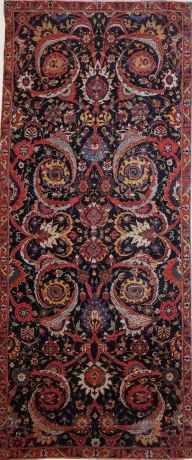
In this version, it does seem to resemble leaves a little more although the swirling movement of fish and water
is also very striking. Perhaps it’s a double image – the fish imagery would tend to support Gantzhorn’s assertion
that these carpets are in fact not Indian (or classical Persian), as others have asserted, but rather of Armenian
manufacture. And the fish, of course, are an ancient Christian symbol.
Here’s an excerpt from Gantzhorn’s book, pp. 391:
“Much like Mehmed II in Istanbul 150 years before, Shah Abbas I encouraged the resettlement of large segments of
the Armenian population in the immediate area of his residence in Isfahan. New Julfa became a point of convergence
for these Armenians who were bestowed considerable privileges and who, because of their skills. . . helped Isfahan
rise to a flourishing center for trade and intellectual thought within a very short time.
“… as early as 1618 Armenians held the monopoly in the prestigious silk trade between Persia and the rest of the
world.”
And on page 399:
“The enforced colonization by Shah Abbas I of entire segments of the Armenian population during the first few years
of the 17th century…was not restricted to Isfahan/New Julfa. The migration of large family groups led from Tabriz
and Isfahan south into the Qashqai desert regions…The region of south-western Persia had already once been settled,
1,000 years previous to this, by Armenian artisans at the decree of the Sassanids. They were then forced to establish
a textile industry there.”
I believe Gantzhorn makes some interesting points about the possible manufacture of these rugs as well as, by implication,
the SYMBOLIC nature of their designs. However, from a formal sense we can clearly see the resemblance to leaf-like
forms with a floral center. The movement, though, is vigorous and suggests great energy – perhaps that of living
creatures.

The next carpet is a Dragon & Phoenix rug, 15th century Anatolian – although exactly who made it is not clear.
I believe this has been widely attributed to Turkic weavers.
However, as Gantzhorn points out on pages 192-194 of his book, the dragon and the phoenix are both very ancient
symbols. Juxtaposed like this he asserts they stand for “eternal life”.
The phoenix has been known in the West, according to Gantzhorn, since the first century C.E. However – she is actually
much older than that, I believe, appearing in Greek mythology several hundred years B.C.E. And the phoenix on this
particular rug bears Christian symbols for Jesus and Eternal Life: look closely on the body of the phoenix, and
you will see “S” forms and also “e” forms.

According to Gantzhorn’s theory, this indicates that the carpet was a Christian piece, bearing Christian symbols;
probably, by his reasoning, it was made by Armenians albeit in Anatolia.
However, as I pointed out in my initial post, the “S” symbol also stands for dragon or serpent, water and is also
associated with Woman – a much older association although related as well to the concept of eternal life or rebirth.
And in outline the “e’s” look very much like crescent moons, which also relate to femininity as well as the principle
of death and rebirth. These are concepts that extend back even further into the history of Mesopotamian and West
Asian history, back to the time of the agricultural people who worshipped the Goddesses. Although remnants of belief
in these deities probably extended into Mohammed’s time, they were severely challenged by the influx of monotheist,
pastoral nomads from the north in about 3100 B.C.E.
Therefore, I’m curious. If we’ve somewhat challenged, if not debunked, the notion that Mongol horse cultures were
not originally weavers of pile carpets – hence, the Turkic carpet may itself have been a later development; and
if the symbols of dragon, phoenix, S and E aren’t necessarily Christian – is there any STRUCTURAL or other compelling
reason why this carpet could not have been made by Kurds?
In any case, here’s the final piece.
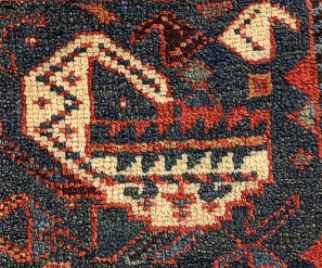
Simply on the basis of formal comparison, note the similarity to the jagged, muscular form of the phoenix/dragon
carpet. Now go look at a detail of the leaves/fish:
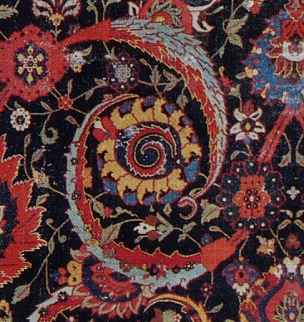
What does this form LOOK LIKE? Here’s a detail of the dragon/phoenix carpet:
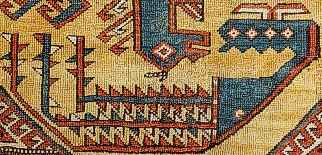
And here again the detail from the Kurdish bagface:

Finally, as Ludwina pointed out – in the case of undocumented weavings, we probably won’t find a “Rosetta stone”
of symbol language. But we have documentation of the usage of many symbols found in carpets. They are also found
in other forms of art, including the written word, as well as paintings, mosaics, pottery and especially sculpture,
which date back thousands of years. Is it so unreasonable to suggest that they may have retained some of their
original meanings, at least to some people; or acquired new ones as belief systems changed?
So I’m trying to make a double point here: 1. simply looking at the designs – making a FORMAL COMPARISON, we see
a dissimilarity to one form and a striking similarity to another, and 2. they may represent very different SYMBOLS,
which could link them to different weaving groups than we’ve previously assumed.
Finally, I think our inquiries into the history of Armenian and Kurdish weaving AND CULTURE, need to surge forward.
We may need to set aside what we THINK we know and examine other possibilities.
And – alarmingly – I’m beginning to thing the critter on my bag looks an awful lot like – A PHOENIX.

Posted by Patrick Weiler on 02-18-2002 07:34 PM:
More Dragons?
Sophia,
The photos below show a bagface likely made at about the same time as your "Dragon-Herati" bagface:
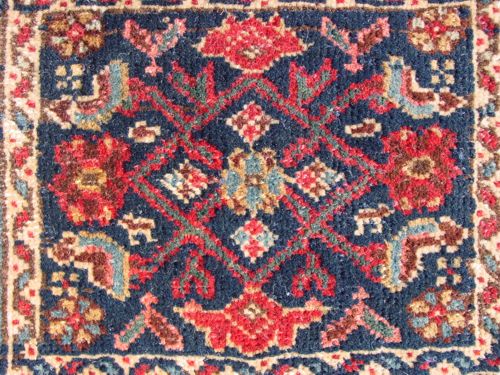
It is a more formal (yet still tribal?) version of the Herati motif in a Bijar bagface. You can see the fully depressed
warps in this view of the back:
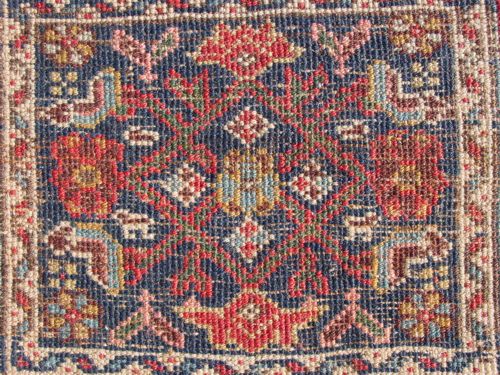
Note the light pink highlights in some areas of the bagface. This is not bleeding, but pink dyed wool not uncommon
to older Bijar weavings.
It is accepted that weavers in the Bijar tradition are mostly Kurdish, so is this bagface just a different rendition
of the same design? Is it a more accurate rendition of a design which took a "left turn at Dragon Street"
in your bagface?
The name "Herati" pattern itself indicates that the urban version was common in Herat, to the east of
traditional Kurdish territory. We know the Kurds were moved to the Mashad area, still to the west of Herat, long
before these weavings were made, but I do not recall any Kordi versions of the Herati pattern bagfaces.
If both versions were being made by traditional Kurdish weavers contemporaneously, is the difference just because
one version was more urban, therefore closer to the tradition, than the more rustic "Dragon" version?
Or was the "Dragon" version, if in fact it is such, purposely designed to relate to an entirely different/dragon
source?
Did each version arrive at its end-point in these bags by traveling a different path from the same original source?
These are a lot of questions which do not actually relate to the original Salon question, since neither rug is
from the Caucasus, but one thing is fairly certain, these bags were not the influence for the Dragon Carpets, nor
were the Dragon Carpets the likely influence for these bags.
Influentially yours,
Patrick Weiler
Posted by Sophia Gates on 02-18-2002 08:59 PM:
Dear Michael:
Good comparison! And an interesting piece!
Before we get started though, I'd like to make it clear that I never intended to give the idea that this sort of
bag is either an ancestor or a descendant of the old Dragon Rugs. As I've written in my long post on the subject,
I believe those go all the way to China, either as a primary or as a secondary source. In other words, people were
either directly influenced by actual Chinese embroideries or other art forms or they were influenced by embroideries,
etc. which may themselves have been influenced by Chinese art. That's why I posted all those scans of Central Asian
embroideries. I felt that the type of spacing generated by embroidered designs, along with certain flat-woven weaving
techniques, was much closer to explaining the Dragon Rugs in design terms than other previously offered ideas.
Now, I'd like to re-post the link to show my whole bag. I think it's strikingly dissimilar to the Bidjar:
http://orientalrug.topcities.com/no9921.htm
In some respects, the designs are similar. One sees a sort of center - a strong one in the Bidjar, around which
are four larger elements along with some secondary design elements. So there is a basic similarity in the layout
of the pattern
But the overall impression of the two designs is quite different, I think. And the large elements themselves show
very little in common - the one being extremely jagged, toothy; and the other is much smoother, quieter In any
case it doesn't look "beastly". In fact, the entire bagface exhibits much more of a floral, and by implication,
leafy, impression. So this one I could possibly see as having had a "herati" ancestor.
The other bag, though, is essentially geometric in nature. Not just the toothed forms, but the whole bag. I think
it may have had a different source of inspiration.
I was thinking, when I was writing this post - people commission weavings. So, even if the Kurds can't be demonstrated
to have had a religious or mythological connection to dragons, there's no reason a Kurdish person couldn't have
woven a piece for somebody else, which would contain dragon imagery. That might resolve some of the conflict over
this issue.
So, simply because the Berlin piece hails from Anatolia, it doesn't necessarily follow that it was made by Turks.
And it doesn't necessarily follow that a piece like this, rather than the floral idea, couldn't have been the design
ancestor of my bag.
The Strock bag presents still another, more animal-like design. Again, apart from the four-big-elements-in-the-corners
layout, it doesn't resemble the Bidjar at all.
So I think it's worth investigating other ideas besides the Herati.
PS - arent' we now thinking of at least some Bidjar weavers as Afshar?
Posted by Patrick Weiler on 02-19-2002 02:53 PM:
Quite a Fight
Sophia,
The design of the Phoenix and Dragon rug you show portrays a dragon fighting a phoenix. They are not so inextricably
intertwined, however, as to obscure the identity of each of the combatants. I believe you have mistaken the dragon
for the phoenix!
The creature with the "e" designs is, in fact, the dragon. Consequently, the "e" shapes would
probably have been the "spots" on the skin of the dragon rather than religious symbols, at least in the
original versions from which this rug takes its inspiration.
There is another item you mentioned that sparked a question in my mind. You say there were "monotheist pastoral
nomads from the north in about 3,100 BCE".
I am not immediately familiar with monotheism having been established quite that far back. What religion was this
and what tribe of people were they?
I will have to go back to the Gantzhorn book to check his footnotes and references, but his assertion that the
Armenians controlled the silk trade in Persia by 1618 would not necessarily argue for their dominance in the design
and manufacture of rugs.
Granted, he certainly presents a stew of disparate statements and herds them into a broad generalization of Armenian
primacy. And the pictures are great!
Patrick Weiler
Posted by Sophia Gates on 02-19-2002 03:31 PM:
Will The Real Dragon Please Stand UP!
Dear Patrick, et.al.,
Oh dear. I went to check Gantzhorn, to see if he said the symbols are on the dragon, not the phoenix as I'd assumed
- and it appears he has them confused also.
Page 193.
I guess I assumed that the snaky looking fellow was the dragon.
Well, if the not-so-snaky looking fellow is actually the dragon and the snaky person is the Phoenix, I guess my
guys are back to being dragons again.
They do prefer flying around spitting flame to being immolated alive
Eternal life or no eternal life! They're like me, they detest pain
Am I getting punchy or what?
But I still think they're symbols Same with the little "s" and crescent moon forms on my Star Lattice rag. If I have the energy I will
explain the long, deep history of The Goddess in the region, who by the time the Dragon/Phoenix rug AND the Star
Lattice piece were woven, would have been STRICTLY VERBOTTEN.
Same with the little "s" and crescent moon forms on my Star Lattice rag. If I have the energy I will
explain the long, deep history of The Goddess in the region, who by the time the Dragon/Phoenix rug AND the Star
Lattice piece were woven, would have been STRICTLY VERBOTTEN.
At least in public. Crypitically - and Steve has already raised the possibility of cryptic people on his Shirvan
- she might have been "remembered" by the weavers. If they were women, they might well have identified
with a female diety and protectoress. After all, many of us still do
The 3100 date is given by some anthropologists; others say mid to late 2000's, for an invasion by Indo-Europeans
who worshipped a male god. Another source says people with Asian and Semitic characteristics. Alas, there is confusion
about who & when in the literature. I'll have to poke around for a direct quote.
Later, gator! Or is that phoenix?
Posted by Sophia Gates on 02-19-2002 04:45 PM:
Dating Ancient Events
Dear Patrick et.al.,
I've been trying to arrive at a time-line for the invasions of Asia Minor, the Middle East and Egypt, which brought
with them people who worshipped "a father god" and/or "a young Warrior god" - and I'm coming
up with all sorts of conflicts depending upon which book one is reading.
And, what constitutes real "monotheism" - as Patrick points out, this may have been a gradual development
from within a particular group.
To say the least this is complicated and I'd like to drop the subject for now because I don't want to say one thing,
then find three different other ideas - as I have just in the past hour. While in a sense I think it's pertinent
to our subject, especially in the context of the ancient Goddesses of Asia Minor, Egypt and The Middle East, I
think we should perhaps stick a LITTLE closer to the rugs
And, to make things ever more interesting, another writer has gone even farther back, into the history of Ancient
Europe, which she states (in The Chalice & The Blade) had been well civilized and peaceful as early as 4000
BC - but then was subjected to a series of attacks by "barbarians" - those Pastoral Horse People again?
- which destroyed that civilization. By her reckoning, then, a European civilization had come and gone by the time
Sumeria was a power, or the first dynasties of Egypt had been formed.
So - as you can see, history itself is a fluid affair, in terms of how we understand it; in the form of new discoveries
which change our perceptions; and certainly I think, depending upon the point of view of the anthropologists, archaeologists
and historians who write it.
No wonder the Caucasian Question is a bit complex









